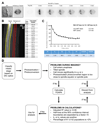Dissecting the role of the tubulin code in mitosis
- PMID: 29804676
- PMCID: PMC6402544
- DOI: 10.1016/bs.mcb.2018.03.040
Dissecting the role of the tubulin code in mitosis
Abstract
Mitosis is an essential process that takes place in all eukaryotes and involves the equal division of genetic material from a parental cell into two identical daughter cells. During mitosis, chromosome movement and segregation are orchestrated by a specialized structure known as the mitotic spindle, composed of a bipolar array of microtubules. The fundamental structure of microtubules comprises of α/β-tubulin heterodimers that associate head-to-tail and laterally to form hollow filaments. In vivo, microtubules are modified by abundant and evolutionarily conserved tubulin posttranslational modifications (PTMs), giving these filaments the potential for a wide chemical diversity. In recent years, the concept of a "tubulin code" has emerged as an extralayer of regulation governing microtubule function. A range of tubulin isoforms, each with a diverse set of PTMs, provides a readable code for microtubule motors and other microtubule-associated proteins. This chapter focuses on the complexity of tubulin PTMs with an emphasis on detyrosination and summarizes the methods currently used in our laboratory to experimentally manipulate these modifications and study their impact in mitosis.
Keywords: Detyrosination; Microtubules; Mitosis; Mitotic spindle; Tubulin code; Tubulin posttranslational modifications; Tyrosination.
© 2018 Elsevier Inc. All rights reserved.
Figures








Similar articles
-
The Tubulin Code, from Molecules to Health and Disease.Annu Rev Cell Dev Biol. 2023 Oct 16;39:331-361. doi: 10.1146/annurev-cellbio-030123-032748. Annu Rev Cell Dev Biol. 2023. PMID: 37843925 Review.
-
The Tubulin Code in Mitosis and Cancer.Cells. 2020 Oct 26;9(11):2356. doi: 10.3390/cells9112356. Cells. 2020. PMID: 33114575 Free PMC article. Review.
-
Mitosis. Microtubule detyrosination guides chromosomes during mitosis.Science. 2015 May 15;348(6236):799-803. doi: 10.1126/science.aaa5175. Epub 2015 Apr 23. Science. 2015. PMID: 25908662 Free PMC article.
-
The Tubulin Code: A Navigation System for Chromosomes during Mitosis.Trends Cell Biol. 2016 Oct;26(10):766-775. doi: 10.1016/j.tcb.2016.06.001. Epub 2016 Jun 22. Trends Cell Biol. 2016. PMID: 27344407 Free PMC article. Review.
-
The tubulin code: molecular components, readout mechanisms, and functions.J Cell Biol. 2014 Aug 18;206(4):461-72. doi: 10.1083/jcb.201406055. J Cell Biol. 2014. PMID: 25135932 Free PMC article. Review.
Cited by
-
Transcriptomics-informed pharmacology identifies epigenetic and cell cycle regulators that enhance AAV production.Mol Ther Methods Clin Dev. 2024 Nov 18;32(4):101384. doi: 10.1016/j.omtm.2024.101384. eCollection 2024 Dec 12. Mol Ther Methods Clin Dev. 2024. PMID: 39687728 Free PMC article.
-
α-Tubulin detyrosination links the suppression of MCAK activity with taxol cytotoxicity.J Cell Biol. 2023 Feb 6;222(2):e202205092. doi: 10.1083/jcb.202205092. Epub 2022 Dec 2. J Cell Biol. 2023. PMID: 36459065 Free PMC article.
-
Synthetic Peptides Induce Human Colorectal Cancer Cell Death via Proapoptotic Pathways.ACS Omega. 2024 Oct 11;9(42):43252-43263. doi: 10.1021/acsomega.4c08194. eCollection 2024 Oct 22. ACS Omega. 2024. PMID: 39464451 Free PMC article.
-
α-Tubulin detyrosination impairs mitotic error correction by suppressing MCAK centromeric activity.J Cell Biol. 2020 Apr 6;219(4):e201910064. doi: 10.1083/jcb.201910064. J Cell Biol. 2020. PMID: 32328631 Free PMC article.
-
Developmental stages and episode-specific regulatory genes in andromonoecious melon flower development.Ann Bot. 2024 Apr 10;133(2):305-320. doi: 10.1093/aob/mcad186. Ann Bot. 2024. PMID: 38041589 Free PMC article.
References
Publication types
MeSH terms
Substances
Grants and funding
LinkOut - more resources
Full Text Sources
Other Literature Sources
Miscellaneous

